window Oldsmobile Cutlass 1998 Owner's Manuals
[x] Cancel search | Manufacturer: OLDSMOBILE, Model Year: 1998, Model line: Cutlass, Model: Oldsmobile Cutlass 1998Pages: 348, PDF Size: 17.46 MB
Page 11 of 348
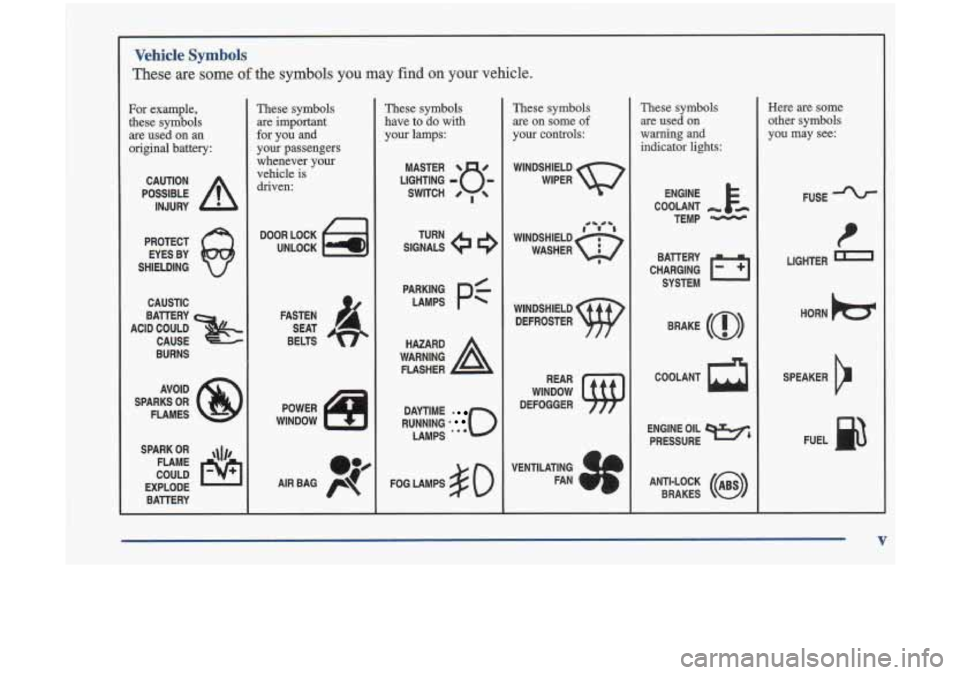
Vehicle Symbols
These are some of the symbols you may find on your vehicle.
For example,
these symbols are used on an
original battery:
POSSIBLE A
CAUTION
INJURY
PROTECT EYESBY
@
SHIELDING
CAUSTIC
ACID COULD BAllERY
CAUSE
BURNS
AVOID
SPARKS OR
FLAM€S
SPARK OR ,\I/,
COULD FLAME
EXPLODE BAllERY
These symbols
are important
for you and
your passengers
whenever your vehicle
is
driven:
UNLOCK Pa
SEAT
BELTS
POWER
WINDOW
.;/
AIR BAG p
These symbols
have to do with
your lamps:
SIGNALS e
TURN
RUNNING
* 0
DAYTIME -
LAMPS .**
FOG LAMPS $0
These symbols
are on some
of
your controls:
WINDSHIELD
wm Q
WINDSHIELD
DEFROSTER
VENTILATING
* 9
FAN 4
These symbols
are used on
warning and indicator lights:
COOLANT
TEMP
-
CHARGING I-1
BAlTERY
SYSTEM
BRAKE
(0)
ENGINE OIL e,
PRESSURE
ANTI-LOCK
(@)
BRAKES
Here are some
other symbols
you may see:
FUSE
LIGHTER
m
HORN )tr
SPEAKER
b
FUEL p3
V
Page 37 of 348
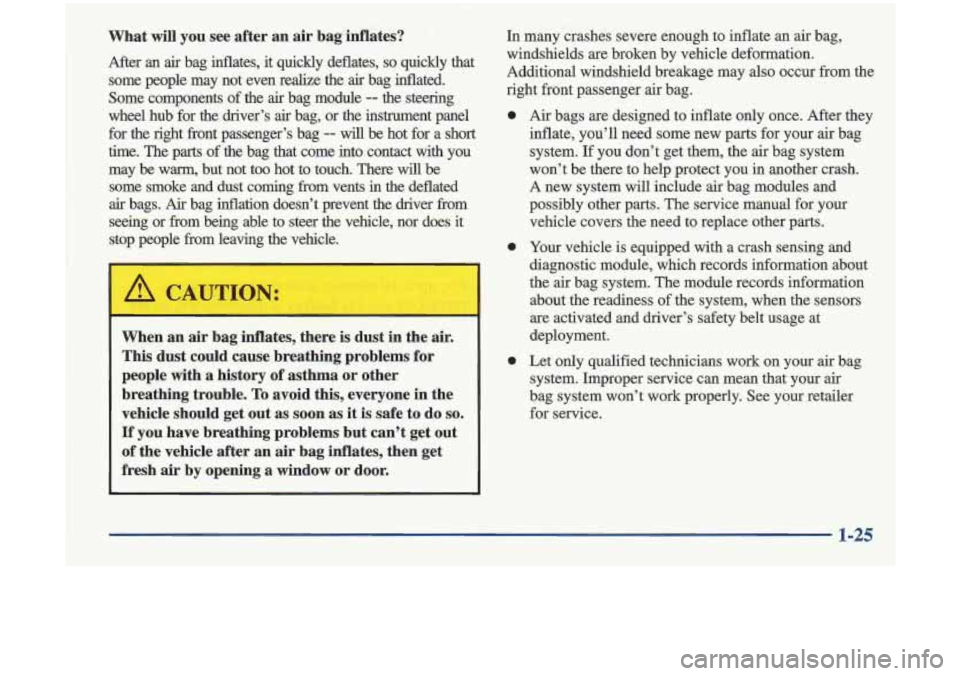
What will you see after an air bag inflates?
After an air bag inflates, it quickly deflates, so quickly that
some people may not even realize the
air bag inflated.
Some components of the
air bag module -- the steering
wheel hub for the driver’s
air bag, or the instrument panel
for the right front passenger’s bag
-- will be hot for a short
time. The parts of the bag that come into contact with you
may be wm, but not too hot to touch. There
will be
some smoke and dust coming from vents in the deflated
air bags. Air bag inflation doesn’t prevent the driver kom
seeing or from being able to steer the vehicle, nor does
it
stop people kom leaving the vehicle.
I
L
~ ~~ ~~
When an air bag inflates, there is dust in the air.
This dust could cause breathing problems for
people with a history of asthma
or other
breathing trouble.
To avoid this, everyone m the
vehicle should get out as
soon as it is safe to do so.
If you have breathing problems but can’t get out
of the vehicle after an air bag inflates, then get
fresh air by opening a window or door.
I
In many crashes severe enough to inflate an air bag,
windshields are broken by vehicle deformation.
Additional windshield breakage may also occur from the
right front passenger air bag.
0
0
0
Air bags are designed to inflate only once. After they
inflate, you’ll need some new parts for your air bag
system. If you don’t get them, the
air bag system
won’t be there to help protect you in another crash.
A new system will include air bag modules and
possibly other parts. The service manual for your
vehicle covers the need to replace other parts.
Your vehicle is equipped with a crash sensing and
diagnostic module, which records information about
the
air bag system. The module records information
about the readiness of the system, when the sensors
are activated and driver’s
safety belt usage at
deployment.
Let only qualified technicians work
on your air bag
system. Improper service can mean that your air
bag system won’t work properly. See your retailer
for service.
1-25
Page 39 of 348
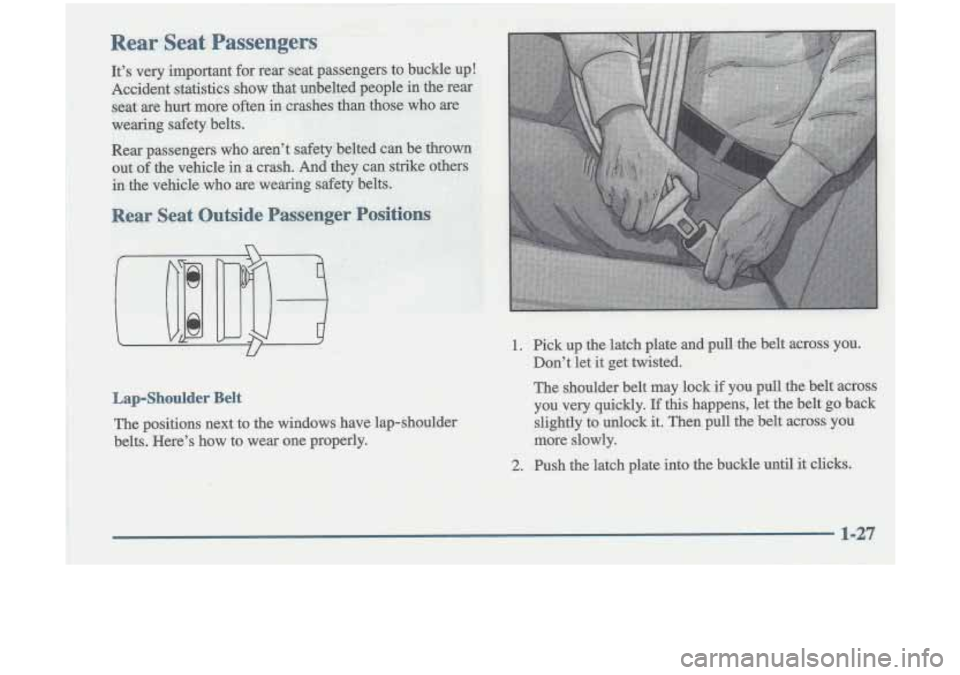
1
1. Pick up the latch plate and pull the belt across you.
Don’t let it get twisted,.
Lap-Shoulder Belt
The positions next to the windows have lap-shoulder
belts. Here’s how
to wear one properly.
Page 65 of 348
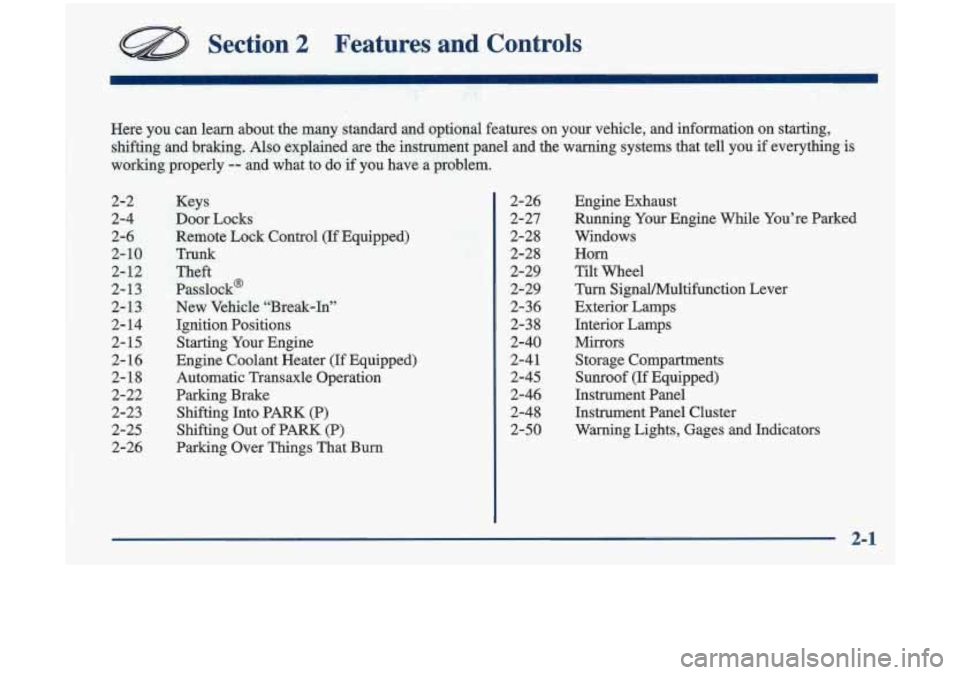
Section 2 Features and Controls
Here you can learn about the many standard and optional features on your vehicle, and inform\
ation on starting,
shifting and braking. Also explained are the instrument panel and the warning systems that tell you
if evewng is
working properly
-- and what to do if you have a problem.
2-2 2-4
2-6
2- 10
2- 12
2- 13
2-13
2- 14
2- 15
2- 16
2-18
2-22
2-23 2-25
2-26
Keys
Door Locks
Remote Lock Control
(If Equipped)
TrWnk
Theft Passlock'
New Vehicle "Break-In" Ignition Positions
Starting Your Engine
Engine Coolant Heater
(If Equipped)
Automatic Transaxle Operation
Parking Brake
Shifting
Into PARK (P)
Shifting Out of PARK (P)
Parking Over Things That Bum 2-26
2-27
2-28 2-28
2-29
2-29
2-36
2-38
2-40
2-4
1
2-45
2-46
2-48
2-50 Engine Exhaust
Running
Your Engine While You're Parked
Windows
Horn
Tilt Wheel
Turn Signal/Multifimction Lever
Exterior Lamps Interior Lamps
Mirrors Storage Compartments
Sunroof (If Equipped)
Instrument Panel Instrument Panel Cluster
Warning Lights, Gages and Indicators
2-1
Page 74 of 348
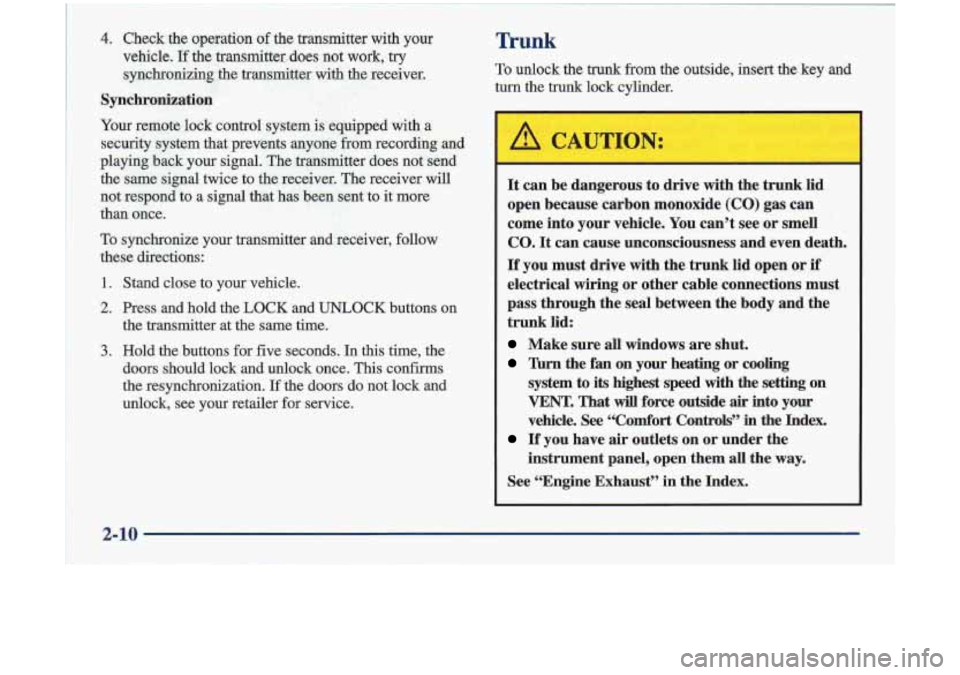
____ ~~ ~ ~~ ~ ~ ~~~
~ ~~~~
4. Check the operation of the transmitter with your
vehicle. If the transmitter does not work, try
synchronizing the transmitter with the receiver.
Synchronization
Your remote lock control system is equipped with a
security system that prevents anyone from recording and
playing back your signal. The transmitter does not send
the same signal twice to the receiver. The receiver will
not respond to a signal that has been sent to it more
than once.
To synchronize your transmitter and receiver, follow
these directions:
1. Stand close to your vehicle.
2. Press and hold the LOCK and UNLOCK buttons on
the transmitter at the same time.
3. Hold the buttons for five seconds. In this time, the
doors should lock and unlock once. This confirms
the resynchronization.
If the doors do not lock and
unlock, see your retailer for service.
~~~ .~ ~~ - ..
Trunk
To unlock the trunk from the outside, insert the key and
turn the trunZC lock cylinder.
It can be dangerous to drive with the trunk lid
open because carbon monoxide
(CO) gas can
come into your vehicle. You can’t see or smell
CO.
It can cause unconsciousness and even death.
If you must drive with the trunk lid open or if
electrical wiring or other cable connections must
pass through the seal between the body and the
trunk lid:
Make sure all windows are shut.
Thrn the fan on your heating or cooling
system to its highest speed with the setting on
VENT. That will force outside air into your
vehicle. See
“Comfort Controls’’ in the Index.
instrument panel, open them all the
way.
If you have air outlets on or under the
See “Engine Exhaust” in the Index.
2-10 B
.-
Page 90 of 348
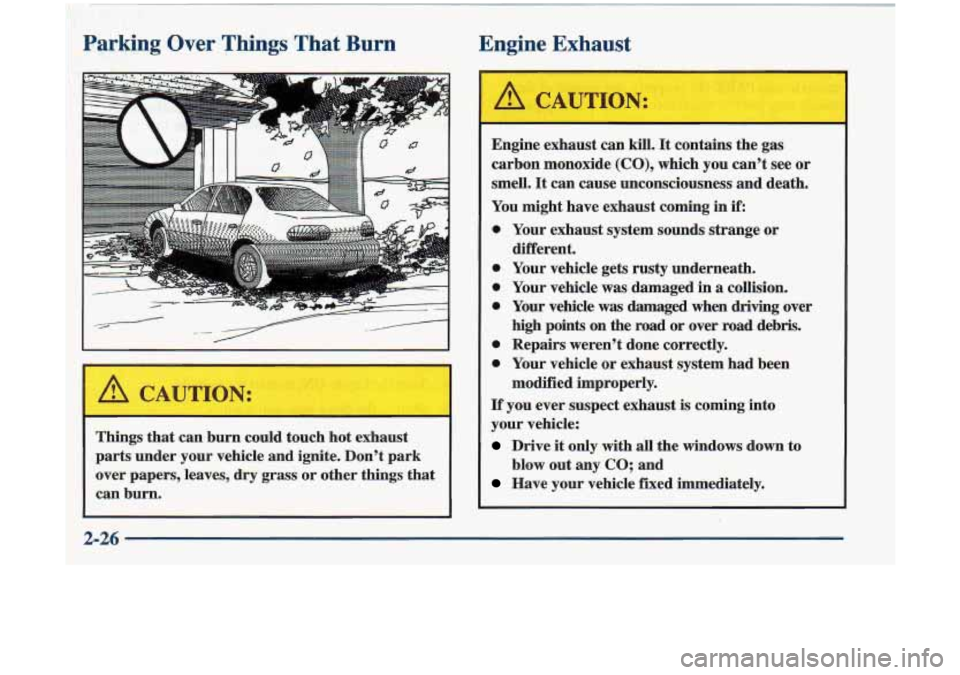
Parking Over Things That Burn
Things that can E TI could touch hot exhaust
parts under your vehicle and ignite. Don’t park
over papers, leaves,
dry grass or other things that
can burn.
I
Engine Exhaust
Engine exhaust can kill. It contains the gas
carbon monoxide
(CO), which you can’t see or
smen. It can cause unconsciousness and death.
You might have exhaust coming in
if:
0
0
0
0
0
0
Your exhaust system sounds strange or
different.
Your vehicle gets rusty underneath.
Your vehicle was damaged in
a collision.
Your vehicle was damaged when driving over
high points on the road or over road debris.
Repairs weren’t done correctly.
Your vehicle or exhaust system had been
modified improperly.
If you ever suspect exhaust is coming into
your vehicle:
Drive it only with all the windows down to
Have your vehicle fixed immediately.
blow
out any
CO; and
Page 92 of 348
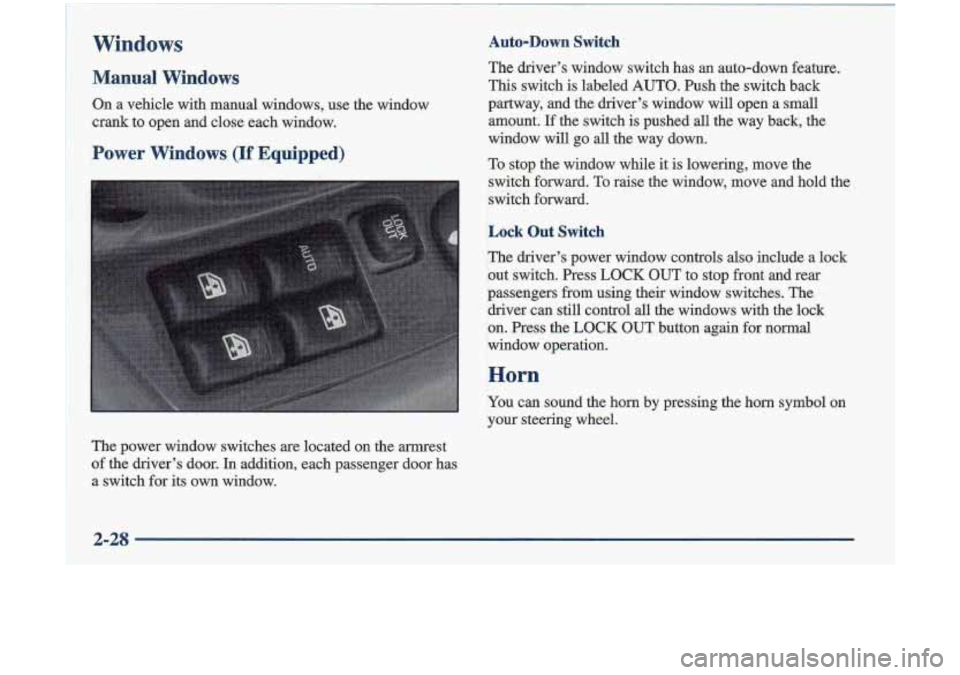
Windows
Manual Windows
On a vehicle with manual windows, use the window
crank to open and close each window.
Power Windows (If Equipped)
The power window switches are located on the armrest
of the driver’s door.
In addition, each passenger door has
a switch for its own window.
Auto-Down switch
The driver’s window switch has an auto-down feature.
This switch is labeled AUTO. Push the switch back
partway, and the driver’s window will open a small
amount.
If the switch is pushed all the way back, the
window will go all the way down.
To stop the window while it
is lowering, move the
switch forward. To raise the window, move and hold the
switch forward.
Lock Out Switch
The driver’s power window controls also include a lock
out switch. Press
LOCK OUT to stop front and reat
passengers from using their window switches. The
driver can still control all the windows with the lock
on. Press the LOCK OUT button again for normal
window operation.
P .. ,.
Horn
You can sound the horn by pressing the horn symbol on
your steering wheel.
2-28
Page 125 of 348
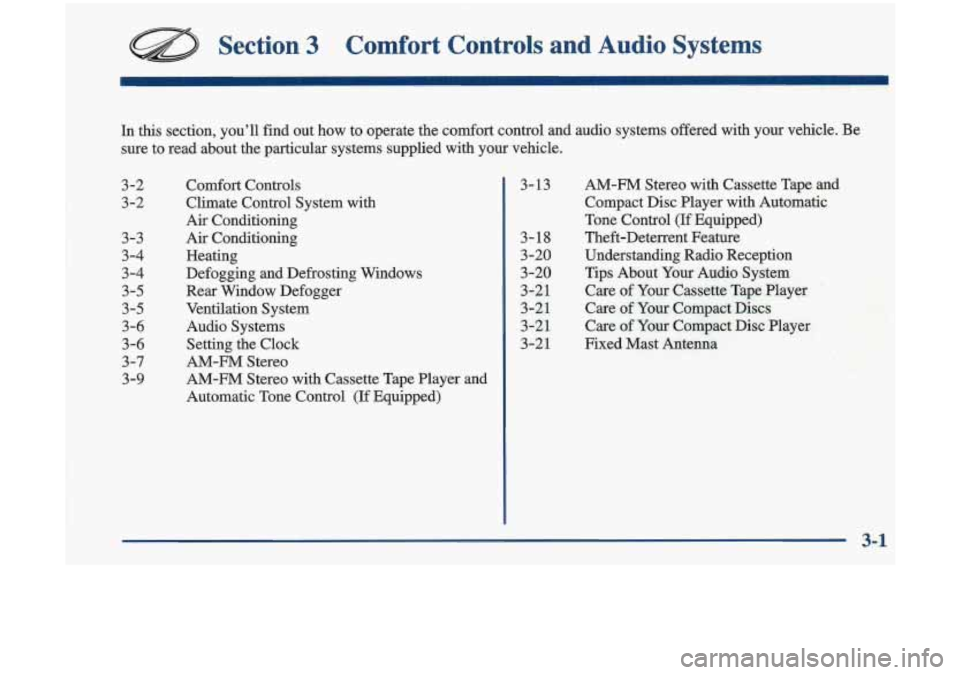
Section 3 Comfort Controls and Audio Systems I
I
1
~
!
In this section, you’ll find out how to operate the comfort control and audio systems offered with your vehicle. Be ~
sure to read about the particular systems supplied with your vehicle.
3-2 3-2
3-3
3-4
3-4
3-5
3
-5
3 -6
3-6
3-7
3-9 Cornfort Controls
Climate Control System with
Air Conditioning
Air Conditioning
Heating
Defogging and Defrosting Windows
Rear Window Defogger
Ventilation System
Audio Systems Setting
the Clock
AM-FM Stereo
AM-FM Stereo with Cassette Tape Player and
Automatic Tone Control
(If Equipped) 3-13
3-18 3-20
3 -20
3-21
3-21
3-21
3-21 AM-FM Stereo with Cassette Tape and
Compact Disc Player with Automatic
Tone Control
(If Equipped)
Theft-Deterrent Feature Understanding Radio Reception
Tips About Your Audio System
Care
of Your Cassette Tape Player
Care of Your Compact Discs
Care of
Your Compact Disc Player
Fixed Mast Antenna
3-1
Page 127 of 348
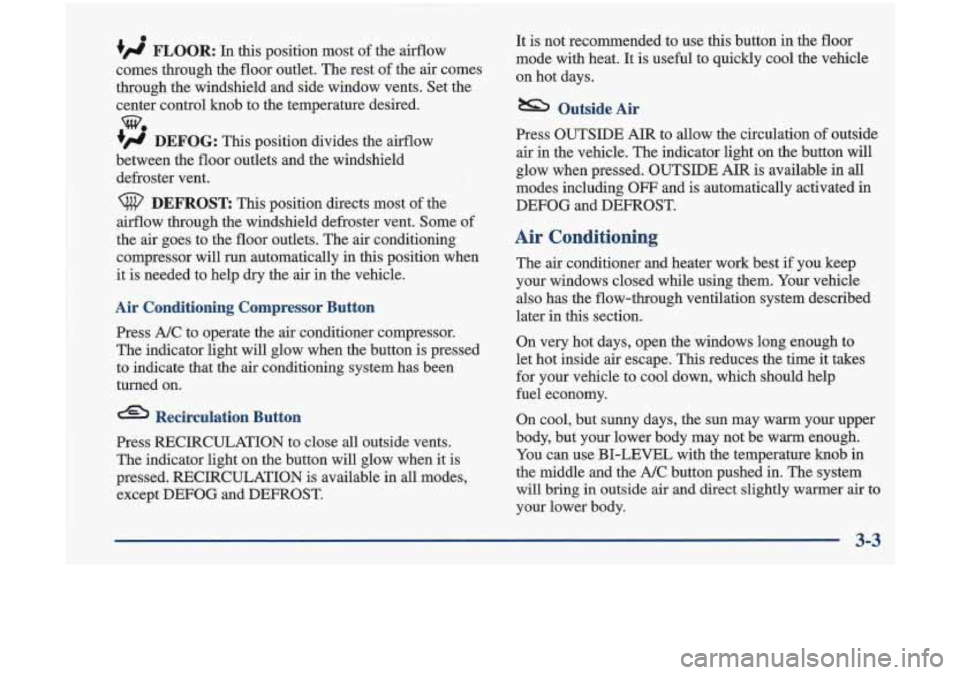
e
+’ FLOOR: In this position most of the airflow
comes through the floor outlet. The rest of the
air comes
through the windshield and side window vents. Set the
center control knob to the temperature desired.
+# DEFOG: This position divides the airflow
between the floor outlets and the windshield
defroster vent.
we
DEFROST This position directs most of the
airflow through the windshield defroster vent. Some of
the air goes to the floor outlets. The air conditioning
compressor will run automatically
in this position when
it is needed to help dry the air in the vehicle.
Air Conditioning Compressor Button
Press A/C to operate the air conditioner compressor.
The indicator light will glow when the button is pressed
to indicate that the
air conditioning system has been
turned on.
Recirculation Button
Press REClRCULATION to close all outside vents.
The indicator light on the button will glow when
it is
pressed. RECIRCULATION is available in
all modes,
except DEFOG and DEFROST. It
is not recommended to use
this button in the floor
mode with heat. It
is useful to quickly cool the vehicle
on hot days.
&b Outside Air
Press OUTSIDE AIR to allow the circulation of outside
air in the vehicle. The indicator light on the button
will
glow when pressed. OUTSIDE AIR is available in all
modes including
OFF and is automatically activated in
DEFOG and DEFROST.
Air Conditioning
The air conditioner and heater work best if you keep
your windows closed while using them. Your vehicle also has the flow-through ventilation system described
later in
this section.
On very hot days, open the windows
long enough to
let hot inside air escape. This reduces the time it takes
for your vehicle to cool down, which should help
fuel economy.
On cool, but sunny days, the sun may warm your upper
body, but your lower
body may not be wm enough.
You can use
BI-LEVEL with the temperature knob in
the middle and the A/C button pushed in. The system
will bring in outside
air and direct slightly warmer air to
your lower body.
I
Page 128 of 348
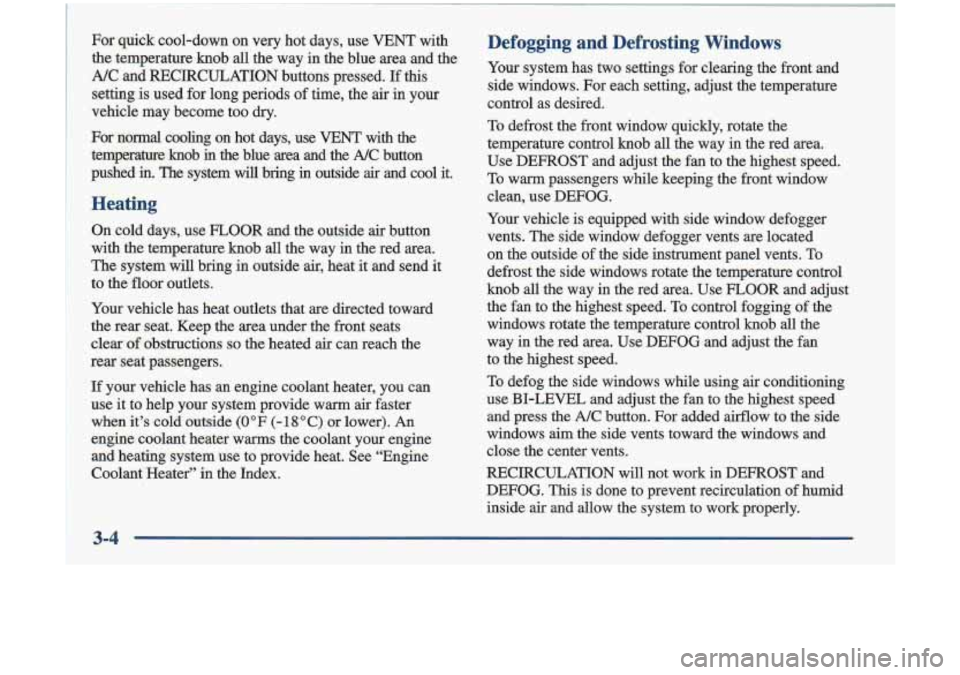
’ . For quick cool-down on very hot days, use VENT with
’ . the temperature knob all the way in the blue area and the
; A/C and RECIRCULATION buttons pressed. If this
; setting is used for long periods of time, the air in your
vehicle may become too dry.
-1 For normal cooling on hot days, use VENT with the
’: temperature knob in the blue area and the A/C button
f pushed in. The system will bring in outside air and cool it.
Heating
On cold days, use FLOOR and the outside air button
I with the temperature knob all the way in the red area.
The system will bring in outside air, heat it and send it
to the floor outlets.
I Your vehicle has heat outlets that are directed toward
I
. : the rear seat. Keep the area under the front seats
’ I clear of obstructions so the heated air can reach the
rear seat passengers.
:If your vehicle has an engine coolant heater, you can
use it to help your system provide warm air faster
when it’s cold outside
(0 OF (- 18 O C) or lower). An
engine coolant heater warms the coolant your engine
and heating system use to provide heat. See “Engine
’ . Coolant Heater” in the Index.
-~ -. ... . ~ ~ ~ ~~ ~ ~
~ .. ~~ __ ~
Defogging and Defrosting Windows
Your system has two settings for clearing the front and
side windows.
For each setting, adjust the temperature
control as desired.
To defrost the front window quickly, rotate the
temperature control knob all the way in the red area.
Use DEFROST and adjust the fan to the highest speed.
To warrn passengers while keeping the front window
clean, use DEFOG.
Your vehicle is equipped with side window defogger
vents. The side window defogger vents are located
on the outside of the side instrument panel vents. To
defrost the side windows rotate the temperature control
knob all the way in the red area. Use
FLOOR and adjust
the fan to the highest speed. To control fogging of the
windows rotate the temperature control knob all the
way in the red area. Use DEFOG and adjust the fan
to the highest speed.
To defog the side windows while using air conditioning
use BI-LEVEL and adjust the fan to the highest speed and press the
A/C button. For added airflow to the side
windows aim the side vents toward the windows and
close the center vents.
RECIRCULATION will not work in DEFROST and
DEFOG. This is done to prevent recirculation of humid
inside air and allow the system to work properly.